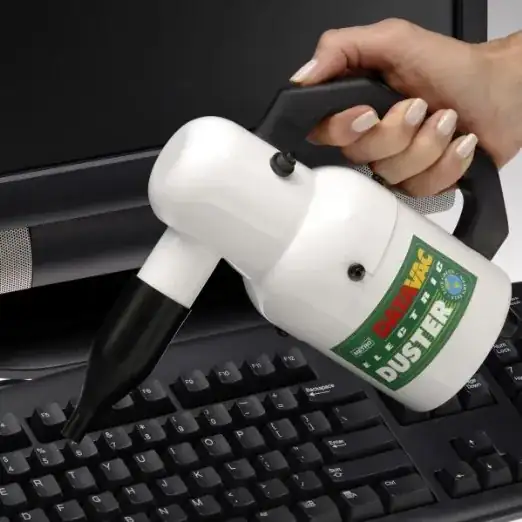Can static electricity build up in vacuum cleaners, and in particular, their nozzles?
Yes, vacuum cleaners can indeed build up a noticeable static charge. The amount of charge buildup can vary depending on several factors, such as the type of vacuum cleaner used, the amount and type of dust present, and, as with any static buildup, ambient air humidity.
The main source of this static buildup appears to be from dust particles striking the walls of the plastic inlet nozzle / tube, picking up a charge (and leaving an opposite charge on the nozzle) through the triboelectric effect. Thus, the charge accumulates not only on the body of the vacuum cleaner, but also on the nozzle and the hose. In fact, this can be quite easily observed by vacuuming the floor in dry weather: some dust tends to cling to the top side of the nozzle, and can be quite resistant to attempts to remove it.
Are "electric dusters" necessary? Or can simpler alternatives or basic modifications to the household vacuum cleaner solve this issue?
I regularly clean my computers with an ordinary floor vacuum, and have never experienced any static damage. However, that may well be because I've known about this risk for a long time, and have always taken a couple of simple precautions to avoid it:
Use a conductive nozzle on the vacuum. Most household vacuum cleaners come with one or two metal pipe segments between the flexible tube and the fancy nozzle assembly, so you can just remove the nozzle but leave at least one conductive pipe segment on the tube.
Keep the nozzle grounded to the computer chassis while vacuuming it. This ensures that the vacuum nozzle remains at the same electric potential as the computer equipment, thus preventing any static discharge between them.
You can get fancy and tape a piece of electric wire to the vacuum pipe, with the other end screwed to the computer chassis, or you can wrap one of those anti-static wrist straps around the pipe twice. The simplest way to ground the nozzle, however, is just to ground it through your own body: just hold the (conductive) nozzle in your bare hand, while making sure that your body is grounded to the chassis e.g. through one of those wrist straps, or simply by touching a metal part of the chassis with your other hand.
There are, apparently, also special anti-static vacuum cleaner nozzle / hose assemblies that work on the same principle (ensuring that the nozzle is conductive and grounded). See the patent cited below for one example.
How are the designs of "electric dusters" different to common vacuum cleaners?
I've never used one of those "electric dusters" specifically made for cleaning computers, but I suspect they're based on a similar principle. For example, the one you linked to in your question is advertised as having "sturdy all-steel construction", which would presumably ensure that any static buildup is immediately discharged to ground through the operator's hand.
(Also, the "electric duster" appears to blow air out through the nozzle rather than sucking it in, which may indeed dislodge dust a bit more effectively, as long as you don't mind it being scattered everywhere. This has nothing to do with static electricity, though.)
Have there been any cases of motherboards, or electronics in general, being damaged due to static discharges through the use of vacuum cleaners?
As noted above, I have never managed to damage any electronics with static (as far as I know — static damage is invisible and hard to distinguish from just random equipment failure), with or without a vacuum cleaner. I have also been unable to locate any verifiable reports of someone damaging their computer through static from a vacuum cleaner — alas, it just doesn't seem to be something that people would write up and publish. Thus, for now, I'll have to state that I cannot offer a positive answer to this part of your question.
Supporting sources:
Philips FC8433/02 vacuum cleaner FAQ
"During vacuum cleaning, especially in rooms with low air humidity, your vacuum cleaner builds up static electricity. As a result you can experience electric shocks when you touch the tube or other steel parts of your vacuum cleaner."
U.S. Patent 4,866,565 A: "Vacuum cleaner electrostatic build up control system" (1989)
"It is known that the removal of debris in enclosed areas containing computer equipment, and especially around computer circuit boards, by the usual vacuum cleaning systems can result in static discharge. Consequently, it is a further object of the present invention to effectively eliminate static electricity from damaging circuit boards in computer installations without a reduction in the efficiency of the vacuum system."
